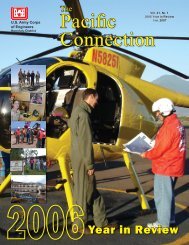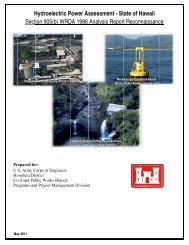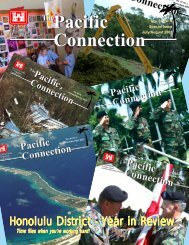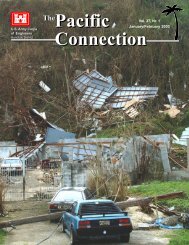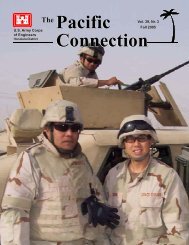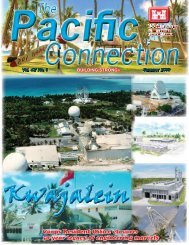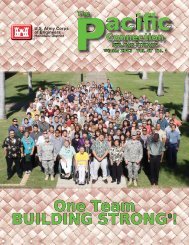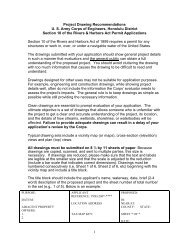8 <strong>The</strong> <strong>Pacific</strong> <strong>Connection</strong> Centennial Edition 1905-2005Pre-WW II: 1940- 1941War Preparations“ If we had had theEngineers on the entireconstruction program lastyear they would havemoved in with an experiencedorganization andmuch waste would havebeen avoided”-Robert P. Patterson, Under Secretary ofWar, in an Aug. 28, 1941 memo to the PresidentRoosevelt calling for all <strong>Army</strong> construction workto be transferred from the Quartermasters to theCorps of Engineers. F.D.R. approved the changeand it was signed into law Dec. 1, 1941.After the Dec. 7, 1941 attack on Pearl Harbor, <strong>Honolulu</strong>Engineers repaired the airstrips on Hickam and Wheeler andcreated new airfield ferry routes across the <strong>Pacific</strong> with recordbreakingspeed--prompting this editorial by Lorrin P. Thurstonthen President of the <strong>Honolulu</strong> Advertiser. Below is an excerptfrom the Feb. 26, 1942 column.A Tribute to a Driving WorkProducing GeniusLast week I stood on a finished airport, oneof many. On December 7, there was nothing therebut sand and swamp. <strong>The</strong> magnitude of the jobwhich was accomplished is breathtaking—that is theonly word that can be fairly used to describe whathas been done.This was only one of the countless dozenof completed projects on many of which work is stillgoing on full blast. Each needed tons of material,thousands of men, equipment mounting intothousands of individual items. <strong>The</strong>y had to begotten from some place. Millions of dollars of costswere involved….However, out of the whole chaotic mess,one thing stands out and that is, that this one man{HED <strong>District</strong> Engineer Col. <strong>The</strong>odore Wyman, Jr.}is the spark plug, the executive head and the drivingforce which got ready and turned over to the <strong>Army</strong>,an incredible number of “must” installations in afraction of the time normally required.As WW II approached, portable storage units such as this one at Wheeler <strong>Army</strong> Air Field,circa 1930. were replaced with extensive underground rooms and tunnels for ammunitionstorage at many locations on Oahu. One worker commented that the Engineers had built somany tunnels, if placed end to end-- the entrance would be at Koko Head, the exit atMoanalua.Prior to the attack on Pearl Harbor, HED was enlarging and modernizingfacilities at Ft. Shafter and Schofield Barracks, building anti-aircraft gun sites,bomb-proofing coastal fortifications and building bunkers at Wheeler <strong>Army</strong> AirField. HED was also finishing extensive work on Hickam Field including a hospital,dental clinic, an engineering shop, barracks, an NCO club, pool and perimeterfencing.After France fell in 1940, America urgently prepared for war and HEDplayed a crucial role in those preparations. In June 1940 the War Departmentauthorized HED to construct three aircraft warning fixed stations: Kaala on Oahu,Haleakala on Maui, Kokee on Kauai and six mobile stations. <strong>The</strong>y were notoperational the day Japan attacked Oahu.Before war was declared, the <strong>District</strong> had been creating a new Airfield FerryRoute System. <strong>The</strong> original route from the Philippines, Marianas, Wake Island, Midway,Hawaii to California was considered vulnerable to Japanese attack. New air ferry routesto the east and south were necessary to the war effort and the military build-up inAustralia.On Oct. 4, 1941, the War Dept. orders HED to begin construction on the newroutes. Building numerous runways and support facilities on small, remote islandspresented a number of challenges including material, manpower and water shortages,communication, transportation and geographical topography problems.Both routes were finished by the one-year anniversary of the attack on PearlHarbor in spite of the fact that airfield pavement was a new and unfamiliar area--animpressive accomplishment even in war time.
Centennial Edition 1905-2005 <strong>The</strong> <strong>Pacific</strong> <strong>Connection</strong> 9WW II: 1941-1943<strong>Pacific</strong> DefensesU.S. Engineers Busy Plugging AllPossible Leaks in Isle DefensesTeamwork Is Keynoteof Builders’ ProgramEver since war burst in Hawaii’sface the hunt for heroes has gone ata good clip. One hunting groundoverlooked so far is the Corps ofEngineers, as the ContinentalCongress of 1775 first named them.While the spotlight of Hawaiiwas fixed on the new stars in themilitary galaxy, these builders of thearmy, with no chance to sparkle, werebusy plugging all possible leaks in theIsland fortifications.<strong>The</strong> men whose technicalengineering skills puts might into thepunch of other combat units werehanded the most burdensome and leastspectacular job at the mobilizationfor total war. Though the casual eyemay fail to see much proof, it is therejust the same.Helping ‘Hold That Line”Unlike star players in a footballgame, none of the engineers couldrace down the battlefield while thecrowd shrieked ‘Hold that line,’ andscore a triumphant touchdown. ButEarly World War-II Milestonesthey could—and did —showteamwork that was a credit toAmerican ingenuity. <strong>The</strong>y not only‘held the line,’ they built some of itunder enemy fire and the rest inpractically nothing flat.<strong>The</strong> U.S. engineers know betterthan any other arm of the servicethat there is no royal road to victory.<strong>The</strong>y build that road, literally as wellas figuratively. In peace, they aretrained and disciplined to roadbuildingon a grand scale, to surveyingboundaries and mapping new landsto building lighthouses, dockyards,dams for flood control, to improvingwaterways in harbors and rivers sothat the life force of an industrialnation—its commerce — might flowfreely as the tide.In war their tasks becomeHerculean. With little opportunitiesto shine as individual Hercules, thesetechnical experts as a close-knit teamshared the service family’sresponsibility and integrity withAmerica in her supreme test and carrya heavy load withal.- excerpt, <strong>Honolulu</strong> Advertiser,Feb. 26, 1942March 1941 to Sept. 1943: Barracks, utilities, runways and taxiwaysconstructed on Bellows <strong>Army</strong> Air Field. Runways started before the attackwere expanded from 2,220 ft. to 4,900 ft. to accommodate B-17s. Area wascompleted in blackout conditions and rain one hour before the first four U.S.planes landed.Dec. 23, 1941: Japanese capture Wake Island. Prior to this, HED had plansto create a harbor on Wake similar to the Welles Harbor project.Dec. 27, 1941: 5,000 ft. runway at Tontouta, New Caledonia completed.1942: Underground gasoline ammunition storage facilities constructed atvarious locations.Jan. 20, 1942: Christmas Island runway completed.March 1942: Start of an extensive cold storage building program on the islands.Design Division developed a self-contained, 200-300 cu. ft. capacitywalk-in portable reefer box for use in isolated areas.1943: Tunnel near Kipapa Gulch, believed to be the first steel-lined gasolinestorage tunnel ever constructed. HED constructed so many tunnels, it wasestimated that if all the tunnels blasted on Oahu during the war were place endto end, the entrance would be at Koko Head and the exit at Moanalua.1943-1944: HED built six Prisoner-of-War camps on Oahu: Honouliuli Gulch,Wahiawa, Sand Island, Schofield Barracks, Fort Hase and Kalihi Valley.Jan. 1, 1943: Brig. Gen. Kramer established the “Bottleneck Buster Division”to simplify procedures in managing the many different new units. Bymid February, Kramer’s executive officer had broken some 400 bottlenecksand dramatically improved the <strong>District</strong>’s efficiency.Feb. 1943: HED begins creating a rear entrance to <strong>Honolulu</strong> Harbor at theurging of Brig. Gen. Kramer to Lt. Gen. Emmons. Considered a militaryemergency, the channel was to be 10,000 ft. long with a pontoon bridge. <strong>The</strong>project was abandoned after the war and not resumed again until 1960.After the Dec. 7th attack, the <strong>District</strong> was suddenly tasked with additionalresponsibilities outside its normal realm and needed additional space to carry onits many new missions. HED moved into Punahou School on Dec. 8, 1941, leasingthe compound for $20,000 a month until Sept. 8, 1945.Six days before Pearl Harbor was attacked, all <strong>Army</strong> constructionprojects were transferred to HED from the Quartermaster Department.Simultaneously, HED acquired responsibility for <strong>Army</strong> and Air Forcereal estate in Hawaii. An explosion of work soon followed.This brought HED into new fields of work with more than 26,000employees. HED repaired the damaged airfields on Hickam andWheeler in record time while completing the new air ferry routes.Practically overnight, the <strong>District</strong> Engineer became responsible fordetermining shipping priorities in the harbor; converting pineapplefields to vegetable farms to feed the troops and the island population;organizing the rationing program; leasing buildings and warehousesand hotels (to temporarily house the massive influx of new recruits);building trenches, shelters, tunnels for ammunition storage; supplyingthe forward bases; selling war bonds and camouflaging landmarks.In 1942, HED entered into a “Plantation Agreement” with variouslocal companies. This provided food for the troops and allowed HEDto use the farm equipment and manpower for military constructionprojects.This time frame also saw some of HED’s most direct contributionsto the war effort: developing bases on three <strong>Pacific</strong> Atolls, transportingSoldiers and supplies and preparing maps.Jan. 1942: Ft. DeRussy area lei makers were recruited to weave rags intonets to hide the islands’ landmarks. HED’s newly-formed CamouflageSection displayed its ingenuity as it incorporated camouflage designs intoevery new building planned and placed patterns over existing criticalfacilities. <strong>The</strong> Camouflage Section also built plywood airplane decoys andplanted vegetables on property used by the military.




